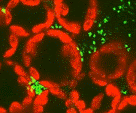Plant Pathology, Department of

Department of Plant Pathology: Faculty Publications
Document Type
Article
Date of this Version
8-22-2022
Citation
Mol Plant Pathol. 2022;00:1–18. DOI: 10.1111/mpp.13268
Abstract
Goss's bacterial wilt and leaf blight of maize (Zea mays) caused by the gram-positive coryneform bacterium Clavibacter nebraskensis is an economically important disease in North America. C. nebraskensis is included within the high-risk list of quarantine pathogens by several plant protection organizations (EPPO code: CORBMI), hence it is under strict quarantine control around the world. The causal agent was reported for the first time on maize in Nebraska (USA) in 1969. After an outbreak during the 1970s, prevalence of the disease decreased in the 1980s to the early 2000s, before the disease resurged causing a serious threat to maize production in North America. The re-emergence of Goss's wilt in the corn belt of the United States led to several novel achievements in understanding the pathogen biology and disease control. In this review, we provide an updated overview of the pathogen taxonomy, biology, and epidemiology as well as management strategies of Goss's wilt disease. First, a taxonomic history of the pathogen is provided followed by symptomology and host range, genetic diversity, and pathogenicity mechanisms of the bacterium. Then, utility of high-throughput molecular approaches in the precise detection and identification of the pathogen and the management strategies of the disease are explained. Finally, we highlight the role of integrated pest management strategies to combat the risk of Goss's wilt in the 21st century maize industry.
Disease symptoms: Large (2–15 cm) tan to grey elongated oval lesions with wavy, irregular water-soaked margins on the leaves. The lesions often start at the leaf tip or are associated with wounding caused by hail or wind damage. Small (1 mm in diameter), dark, discontinuous water-soaked spots, known as “freckles”, can be observed in the periphery of lesions. When backlit, the freckles appear translucent. Early infection (prior to growth stage V6) may become systemic and cause seedlings to wilt, wither, and die. Coalescence of lesions results in leaf blighting.
Host range: Maize (Zea mays) is the only economic host of the pathogen. A number of Poaceae species are reported to act as secondary hosts for C. nebraskensis.
Taxonomic status of the pathogen: Class: Actinobacteria; Order: Micrococcales; Family: Microbacteriaceae; Genus: Clavibacter; Species: Clavibacter nebraskensis.
Synonyms: Corynebacterium nebraskense (Schuster, 1970) Vidaver & Mandel 1974; Corynebacterium michiganense pv. nebraskense (Vidaver & Mandel 1974) Dye & Kemp 1977; Corynebacterium michiganense subsp. nebraskense (Vidaver & Mandel 1974) Carlson & Vidaver 1982; Clavibacter michiganense subsp. nebraskense (Vidaver & Mandel 1974) Davis et al. 1984; Clavibacter michiganensis subsp. nebraskensis (Vidaver & Mandel 1974) Davis et al. 1984.
Type materials: ATCC 27794T; CFBP 2405T; ICMP 3298T; LMG 3700T; NCPPB 2581T.
Microbiological properties: Cells are gram-positive, orange-pigmented, pleomorphic club-or rod-shaped, nonspore-forming, nonmotile, and without flagella, approximately 0.5 × 1–2.0 μm.
Distribution: The pathogen is restricted to Canada and the United States.
Phytosanitary categorization: EPPO code CORBNE.


Comments
Open access